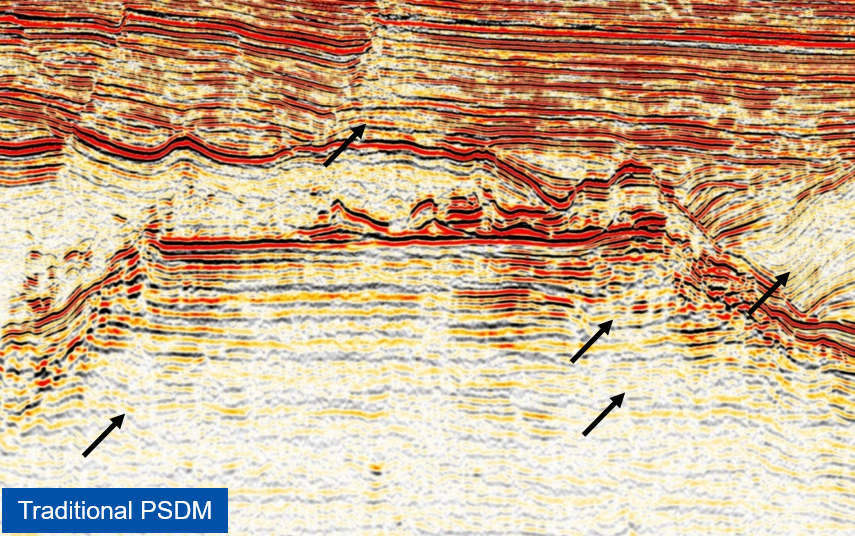Least Squares Q Prestack Depth Migration (LS-QPSDM)
In-Depth Proprietary Technology
Least-Squares Migration is a powerful tool involving demigrating and remigrating seismic data to minimize conflicting errors with the acquired traces, ensuring a refined, high-fidelity, high-res solution when given a good initial migration.
Q-Migration involves modeling the attenuation of seismic signals during migration, allowing the migration to capture the true amplitudes of data weakened by fault shadows and other geological structure. However, increasing these amplitudes may also increase noise.
By combining the strengths of Least-Squares and Q-Migration, we can obtain a high-fidelity, low-noise solution with the strong amplitudes of a Q-Migration and the low noise content of a Least-Squares solution. We can apply this Least-Squares Q approach to any variant of Prestack Depth Migration (e.g. Kirchhoff, Beam, RTM) to ensure the best possible result in regions with complex structure and inconsistent illumination.
To learn more about our LS-QPSDM products, read about our astounding results in the Tengiz oil field with Tengizchevroil (SEG Library):
Bin Gong, Tianjiang Li, King Sim Lee, Zhaobo Meng, Kai Zhang, Assem Bibolova, and Zhanibek Katrenov, (2023), "Application of Q-FWI-tomography and least-squares migration to improve seismic resolution in Tengiz oil field," The Leading Edge 42: 156–164.
Tianjiang Li, King Sim Lee, Bin Gong, Kai Yang, Kai Zhang, Assem Bibolova, and Zhanibek Katrenov, (2022), "Tengiz field fault shadows mitigation with combined joint FWI-tomography, Q-tomography, and least-square migration," SEG Technical Program Expanded Abstracts : 2581-2585.
Fig. 1. Traditional PSDM (left) vs Least-Squares QPSDM (right) on IDG-processed Tengiz data, in partnership with Tengizchevroil. The least-squares approach uses multiple iterations of demigration and remigration to minimize residual errors, while a Q model is used during migration to capture true amplitudes. The LS-QPSDM result is far superior, accurately capturing amplitudes traditionally hidden by fault shadows and absorption in the overburden.
Fig. 2. Traditional PSDM (left), Least-Squares QPSDM (center), and PSDM with AGC normalization applied (right). The original PSDM has large low-amplitude regions at the reservoir level due to fault shadows and absorption in the overburden. LS-QPSDM fixes these issues, illuminating key regions without negatively affecting the rest of the dataset. In contrast, AGC improperly balances the amplitudes, failing to fully illuminate the reservoir area while negatively affecting shallow amplitude continuity.





